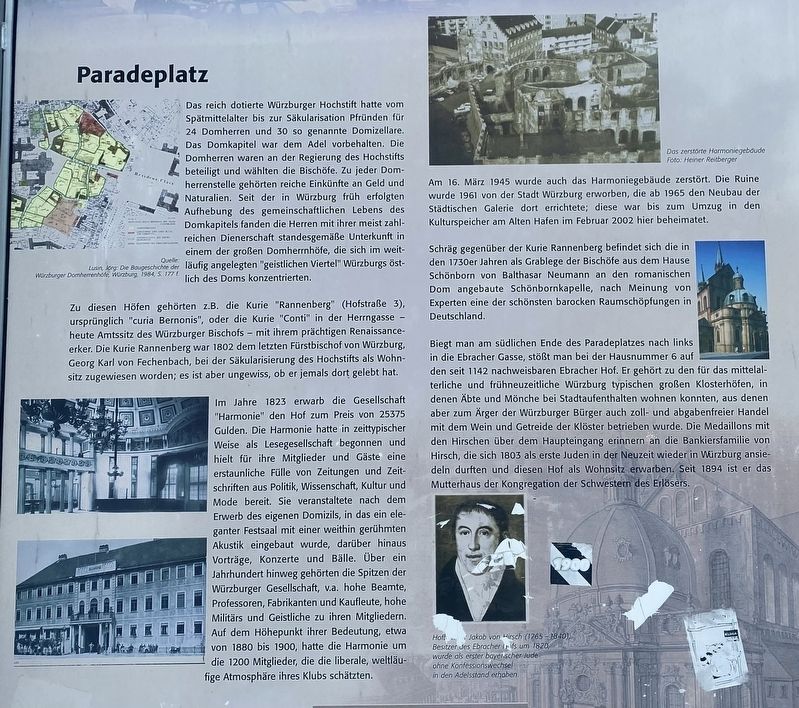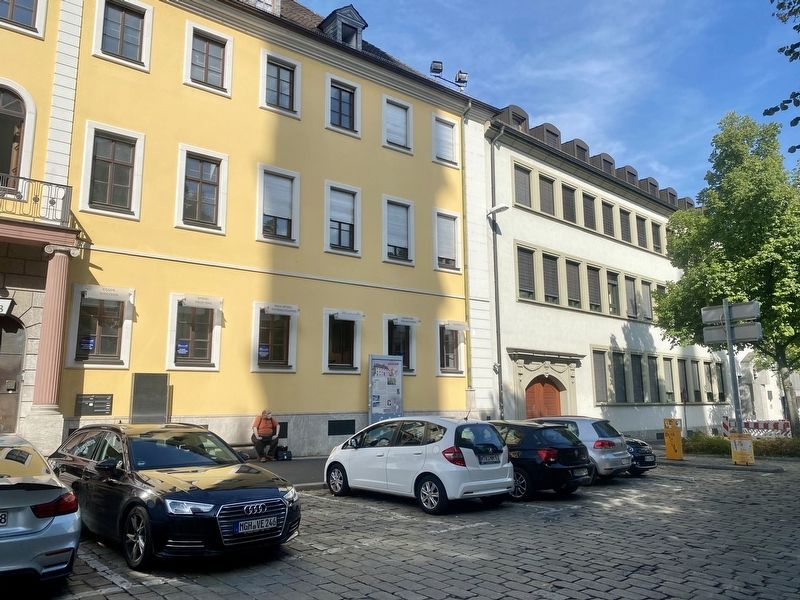Würzburg, Bavaria, Germany — Central Europe
Paradeplatz / Parade Grounds
Zu diesen Höfen gehörten z.B. die Kurie "Rannenberg” (Hofstraße 3), ursprünglich "curia Bernonis", oder die Kurie "Conti” in der Herrngasse - heute Amtssitz des Würzburger Bischofs - mit ihrem prächtigen Renaissanceerker. Die Kurie Rannenberg war 1802 dem letzten Fürstbischof von Würzburg, Georg Karl von Fechenbach, bei der Säkularisierung des Hochstifts als Wohnsitz zugewiesen worden; es ist aber ungewiss, ob er jemals dort gelebt hat.
Im Jahre 1823 erwarb die Gesellschaft "Harmonie” den Hof zum Preis von 25375 Gulden. Die Harmonie hatte in zeittypischer Weise als Lesegesellschaft begonnen und hielt für ihre Mitglieder und Gäste eine erstaunliche Fülle von Zeitungen und Zeitschriften aus Politik, Wissenschaft, Kultur und Mode bereit. Sie veranstaltete nach dem Erwerb des eigenen Domizils, in das ein eleganter Festsaal mit einer weithin gerühmten. Akustik eingebaut wurde, darüber hinaus Vorträge, Konzerte und Bälle. Über ein Jahrhundert hinweg gehörten die Spitzen der Würzburger Gesellschaft, v.a. hohe Beamte, Professoren, Fabrikanten und Kaufleute, hohe Militärs und Geistliche zu ihren Mitgliedern. Auf dem Höhepunkt ihrer Bedeutung, etwa von 1880 bis 1900, hatte die Harmonie um die 1200 Mitglieder, die die liberale, weltläufige Atmosphäre ihres Klubs schätzten.
Am 16. März 1945 wurde auch das Harmoniegebäude zerstört. Die Ruine wurde 1961 von der Stadt Würzburg erworben, die ab 1965 den Neubau der Städtischen Galerie dort errichtete; diese war bis zum Umzug in den Kulturspeicher am Alten Hafen im Februar 2002 hier beheimatet.
Schräg gegenüber der Kurie Rannenberg befindet sich die in den 1730er Jahren als Grablege der Bischöfe aus dem Hause Schönborn von Balthasar Neumann an den romanischen Dom angebaute Schönbornkapelle, nach Meinung von Experten eine der schönsten barocken Raumschöpfungen in Deutschland.
Biegt man am südlichen Ende des Paradeplatzes nach links in die Ebracher Gasse, stößt man bei der Hausnummer 6 auf den seit 1142 nachweisbaren Ebracher Hof. Er gehört zu den für das mittelalterliche und frühneuzeitliche Würzburg typischen großen Klosterhöfen, in denen Äbte und Mönche bei Stadtaufenthalten wohnen konnten, aus denen aber zum Ärger der Würzburger Bürger auch zoll- und abgabenfreier Handel mit dem Wein und Getreide der löster betrieben wurde. Die Medaillons mit den Hirschen über dem Haupteingang erinnern an die Bankiersfamilie von Hirsch, die sich 1803 als erste Juden in der Neuzeit wieder in Würzburg ansiedeln durften und diesen Hof als Wohnsitz erwarben. Seit 1894 ist er das Mutterhaus der Kongregation der Schwestern des Erlösers.
Hofburger Jakob von Hirsch (1765-1840), Besitzer des Ebracher hofs um 1820, wurde als erster bayernscher Jude ohne Konfessionswechsel in den Adelsstand erhoben.
The richly endowed Bishopric of Würzburg had in the late Middle Ages secularized benefices for 24 canons and 30 so-called “domiciles”. The cathedral chapter was reserved for the nobility. The canons were in the bishopric’s government and elected the bishops. Each canon had a rich income of money and natural resources. Since the early abolition of the communal life of the cathedral chapter in Würzburg the lords with their numerous servants found accommodation befitting their status in one of the large canons' courts, which were concentrated in the extensive "spiritual quarter" of Würzburg east of the cathedral.
These farms included, for example, the Curia "Rannenberg" (Hofstraße 3), originally Curia “Bernonis", or the Curia "Conti" in the Herrngasse - today the official residence of the Bishop of Würzburg - with its magnificent Renaissance bay window. In 1802, the Curia of Rannenberg was the last Prince-Bishopric of Würzburg. Georg Karl von Fechenbach was assigned as a resident during the secularization of the bishopric. However, it is uncertain whether he ever lived there.
In 1823, the "Harmonie" Company acquired the farm at a price of 25,375 guilders. The Harmonie had begun as a reading society in a manner typical of the time and had an astonishing wealth of newspapers and magazines on topics covering politics, science, culture and fashion ready for its members and guests. Later it acquired its own domicile, with a widely praised and elegant ballroom. Also acoustics were installed, as well as salas for lectures, concerts and balls. Throughout the century, the top ranks of Würzburg society, especially its high officials, professors, manufacturers and merchants, high military and clergy, were its members. At the height of its importance, from about 1880 to 1900, the Harmony had around 1200 members who appreciated the liberal, cosmopolitan atmosphere of their club.
On March 16, 1945, the Harmony Building was also destroyed. The ruins were acquired in 1961 by the city of Würzburg, which starting in 1965 built the Municipal Gallery there; this was until the move to the Kulturspeicher am Alten Hafen in February 2002.
Diagonally opposite the Curia Rannenberg since the 1730s is the burial place of the bishops from the house of Schönborn constructed by Balthasar Neumann in the Romanesque style. The Schönborn Chapel attached to the cathedral, in the opinion of many experts, is one of the most beautiful Baroque creations in Germany.
If you turn left at the southern end of the Paradeplatz into Ebracher Gasse, you will come across the Ebracher Hof, which can be traced back to 1142, at house number 6. It is one of the large monastery courtyards typical of medieval and early modern Würzburg, where abbots and monks could live during their stays in the city, but from which, to the annoyance of the citizens of Würzburg, duty-free trade in the wine and grain of the monasteries was also carried out. The medallions with the deer above the main entrance are a reminder of the von Hirsch banking family, who were the first Jews in modern times to be allowed to resettle in Würzburg in 1803 and acquired this farm as a residence. Since 1894 he has been the Motherhouse of the Congregation of the Sisters of the Redeemer.
Caption:
Hofburger Jakob von Hirsch (1765-1840), owner of the Ebracher Hof around 1820, was the first Bavarian Jew to be raised to the nobility without changing his religion.
Topics. This historical marker is listed in this topic list: Military. A significant historical year for this entry is 1802.
Location. 49° 47.624′ N, 9° 55.998′ E. Marker is in Würzburg, Bayern (Bavaria). Marker is at the intersection of Hofstraße and Paradeplatz, on the right when traveling west on Hofstraße. Touch for map. Marker is at or near this postal address: Hofstraße 3, Würzburg BY 97070, Germany. Touch for directions.
Other nearby markers. At least 8 other markers are within walking distance of this marker. Würzburg Sinti Memorial (within shouting distance of this marker); Hof Guttenberg / St. Gallus House (within shouting distance of this marker); Schönbornkapelle / Schönborn Chapel (within shouting distance of this marker); Der Kreuzgang des Neumuensterstiftes / The Cloister of the Neumuenster Seminary (about 120 meters away, measured in a direct line); Würzburg Jewish Deportation Memorial (about 150 meters away); Rabbiner Seligmann Bär Bamberger (about 210 meters away); Frühgotische Doppeltoranlage / Early Gothic Double-Gate Structure (about 210 meters away); Julius Reichsgraf Von Soden (about 240 meters away). Touch for a list and map of all markers in Würzburg.
Credits. This page was last revised on April 16, 2023. It was originally submitted on February 15, 2023, by Andrew Ruppenstein of Lamorinda, California. This page has been viewed 66 times since then and 5 times this year. Photos: 1, 2. submitted on February 15, 2023, by Andrew Ruppenstein of Lamorinda, California. • J. Makali Bruton was the editor who published this page.

